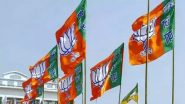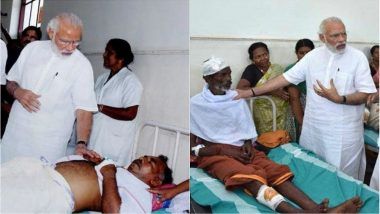New Delhi, Feb 2: The highlight of Union Budget 2018-19, analysts say, is the roll-out of the National Healthcare Protection Scheme (NHPS). Also being touted as 'Modicare' -- reminiscent to former US President Barack Obama's affordable healthcare policy 'Obamacare' -- the programme aims to cover 10 crore households, which would total upto 50 crore beneficiaries.
Modicare: cost, premium, beneficiaries, cover amount and date of implementation
- The NHPS, pegged as the world's largest health insurance scheme, would require an estimated cost of Rs 11,000 crores in the first year. The government has made an initial allocation of Rs 2,000 crore.
- 60 percent of the cost will be borne by Centre, whereas, the remaining 40 per cent burden will be on the States.
- Union Health Minister J P Nadda said the premium charge per household will be around Rs 1,100.
- The beneficiaries include 10 crore lowest earning households of the nation, as per the socio-economic census of 2011. Finance Minister Arun Jaitley said the ultimate number of beneficiaries would add up to 50 crore individuals.
- Each family would be entitled to a yearly cover of Rs 5 lakh. Payment, incase, will be cashless, rather than the system of medical reimbursement, Jaitley said.
- The project is likely to be implemented from either the coming Independence Day i.e. August 15, or from Mahatma Gandhi's birth anniversary on October 2.
Arguments in favour of NHPS:
- Dr Ananya Awasthi , Assistant Director at Harvard India Research Centre, said the scheme would act as a safeguard for the lower-income groups who get plunged into destitution after any member of the family suffers from a lethal disease.
"Nearly six crore Indian households fall below the poverty line only because they are not able to pay for their medical expenses," she said in her column for Swarajya, adding that most among them are Dalits, tribals and rural residents.
- Former Health Secretary Shailaja Chandra said the scheme may succeed in tackling the institutional challenges, as the state governments will have to bear 40 per cent of the medical charges incurred by the NHPS beneficiaries. The onus will be on states if they resort to poor professionalism, she writes in ThePrint.
- Brahma Chellaney, analyst of international geostrategic trends, said the scheme will be a gamechanger for the Indian economy in the years to come. "Better health means increased productivity and greater social mobility: If properly implemented, Modi's plan to give half a billion people free health care—including access to private hospitals—will transform the health sector and yield major socioeconomic benefits in years ahead," he opined.
- According to a report, around 86 per cent of rural populace and 82 percent of their urban counterparts are not covered through any state or private healthcare insurance scheme. As such, the Modicare, if implemented efficiently for half-a-billion people, would emerge as a major step towards 'universal healthcare'.
Arguments against NHPS:
- Pratap Bhanu Mehta, former president of the Centre for Policy Research, described the Modicare as an "appealing policy" but said the amount of fund allocated is inadequate. "Fiscal allocations don’t quite match the costs," he wrote in The Indian Express, further citing the failure of Rashtriya Swasthya Bima Yojana (RSBY), the incumbent central health insurance scheme, which has failed to address the medical expenditure challenges of the masses.
The RSBY, launched in 2008, charges a yearly premium of Rs 365 per household, covering them for medical charges upto Rs 30,000 per year. The scheme was part of the erstwhile government's effort to move towards universal healthcare. However, the implementation remained poor.
- The success of NHPS would be largely dependent upon the healthcare facilities being provided by the state in the remotest parts of the nation. While an announcement has been made to open 1.5 lakh 'wellness centres' across all districts of India -- at least three each in every parliamentary constituency -- it remains to be seen whether the announcement will see the light of the day in near future.
Doubt also looms over the quality of healthcare these proposed wellness centres would provide.
"Benefits of the demand-side financing mechanisms will be not reaped unless the basic health care infrastructure for delivery of primary health services is strong," said an earlier study conducted by School of Public Health, Post Graduate Institute of Medical Education and Research, Chandigarh.
- Neetu Chandra Mishra in Livemint questions whether the government has made adequate amount of allocation towards the healthcare sector, despite making ambitious announcements. Pointing out the need to upgrade the healthcare infrastructure to cover 10 crore households, she says the healthcare sector has received "a meagre hike" of 11.5 per cent.
- Ex-Home Secretary Shailaja Chandra writing for ThePrint claims the 25,000 primary health centres in the country and about 2,000 community health centres remain a less-preferred option even for the poor considering the poor quality of service provided. She doubts whether the 1.5 lakh new wellness centres would be able to provide better services.
- Chandra also expressed apprehensions over the payment module, claiming that "the much smaller" Central Government Health Scheme (CGHS) failed to achieve the desired results as many of the hospitals opted out due to delayed payments by the government. If the government aims to rope in the private sector hospitals, it face cumbersome task of enacting a smooth payment module.
The roadmap for implementation is unclear, which allows the Opposition to tag the ambitious scheme as another jumla. However, keeping political cynicism aside, the criticism from non-partisan quarters, as cited above, could not be ignored.
(The above story first appeared on LatestLY on Feb 03, 2018 03:43 AM IST. For more news and updates on politics, world, sports, entertainment and lifestyle, log on to our website latestly.com).













 Quickly
Quickly




















